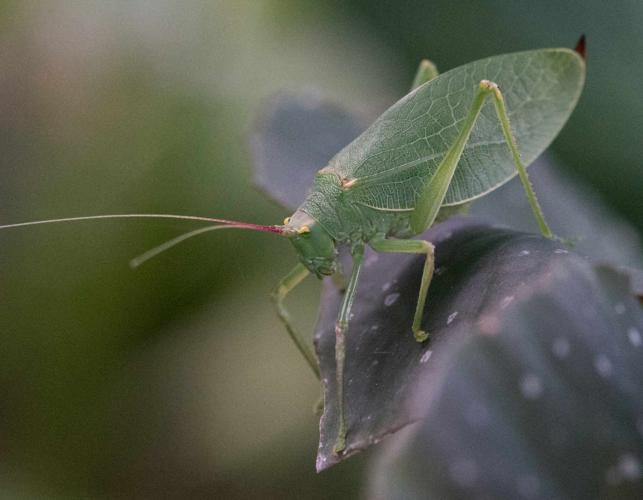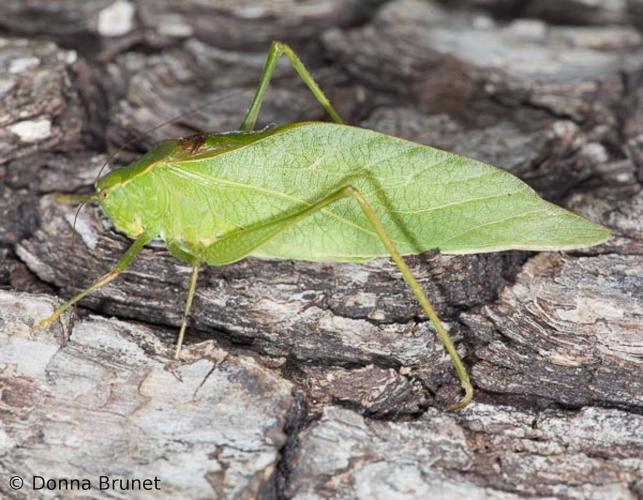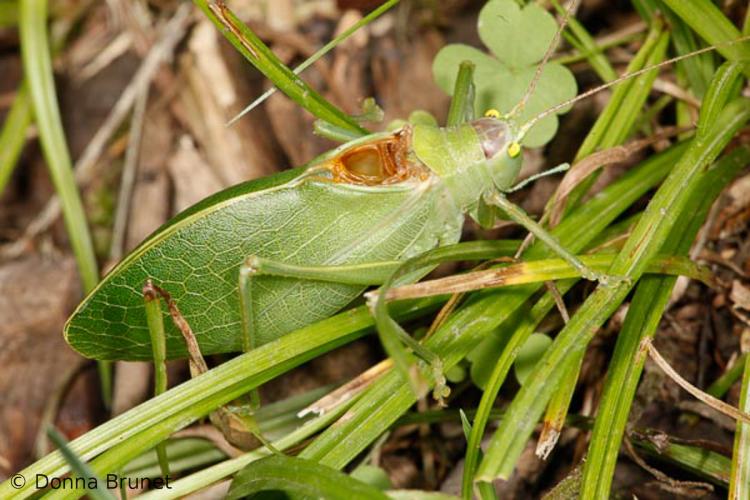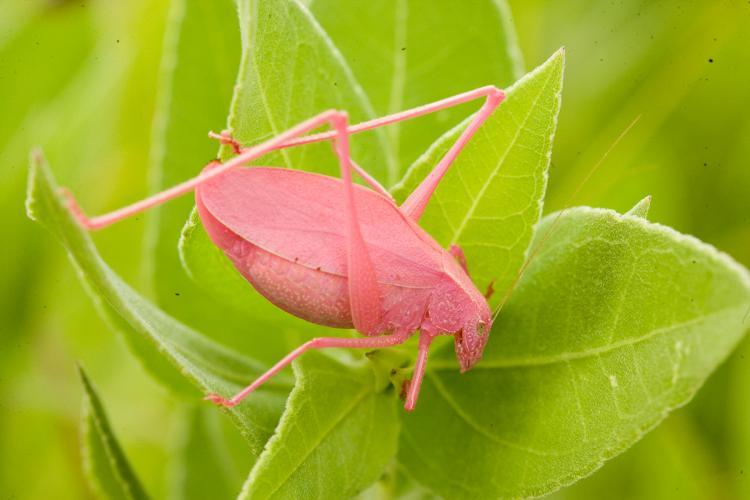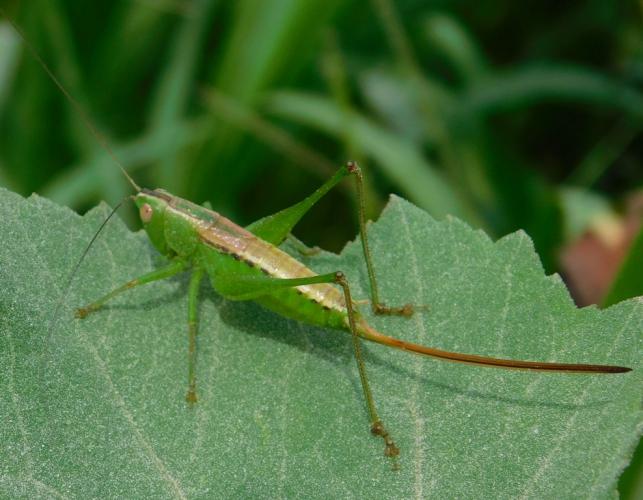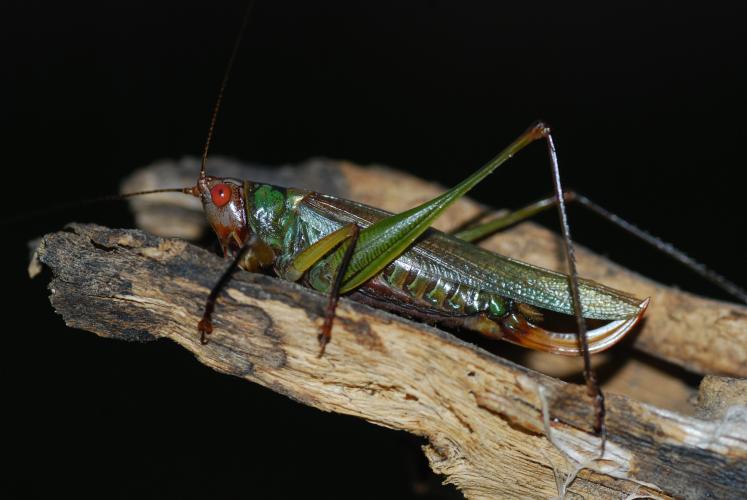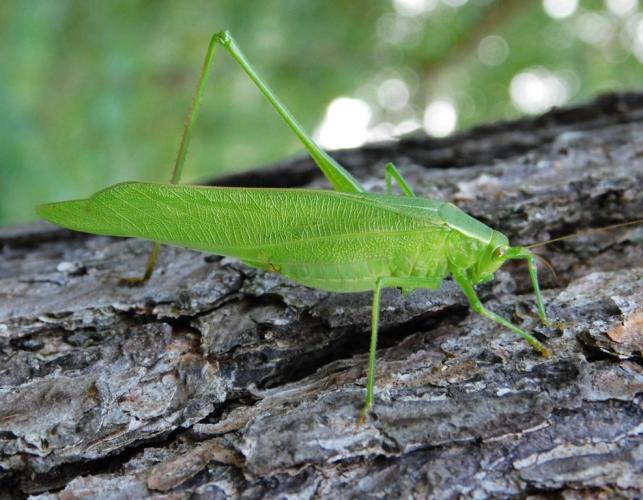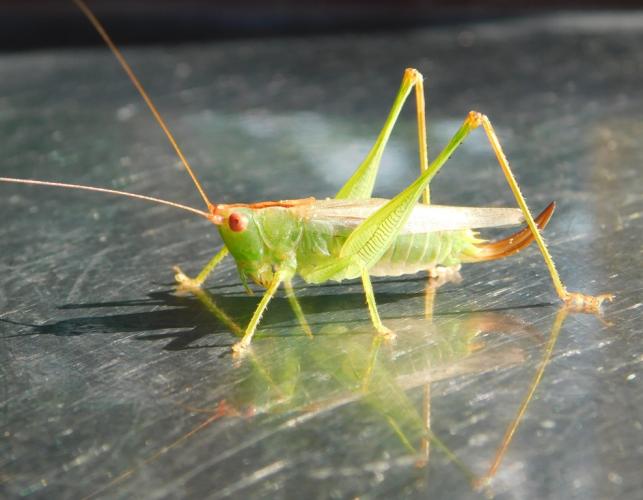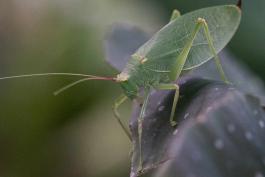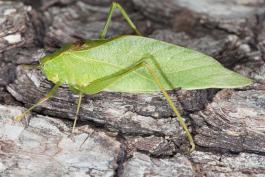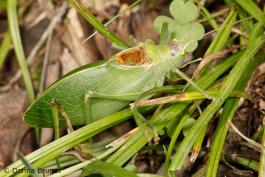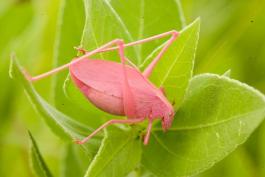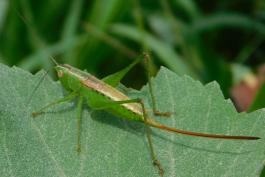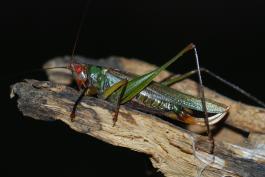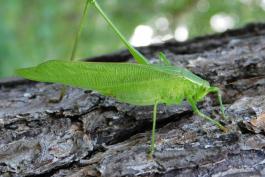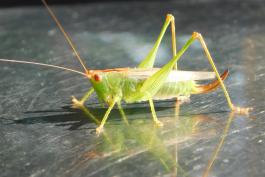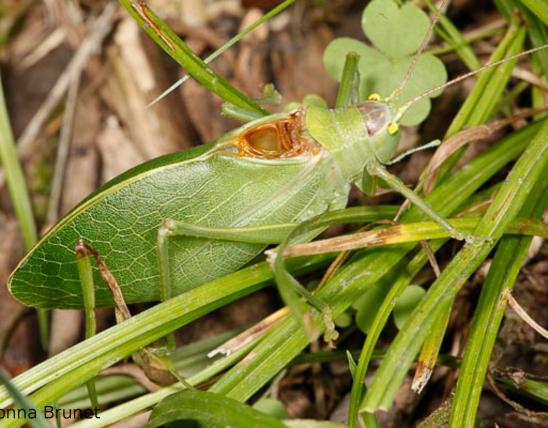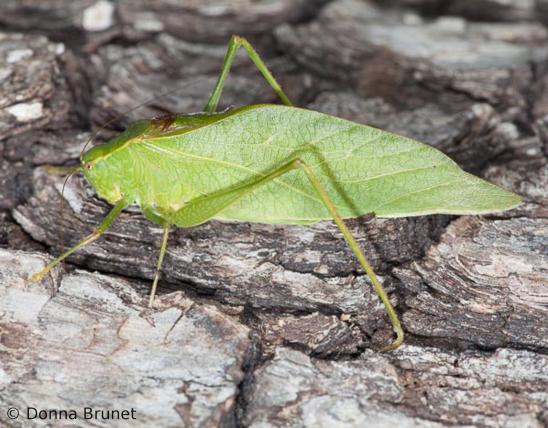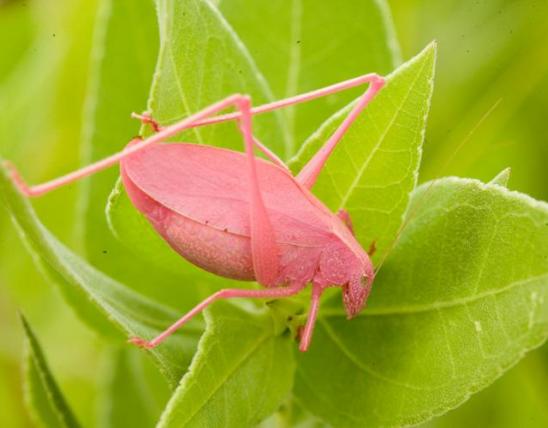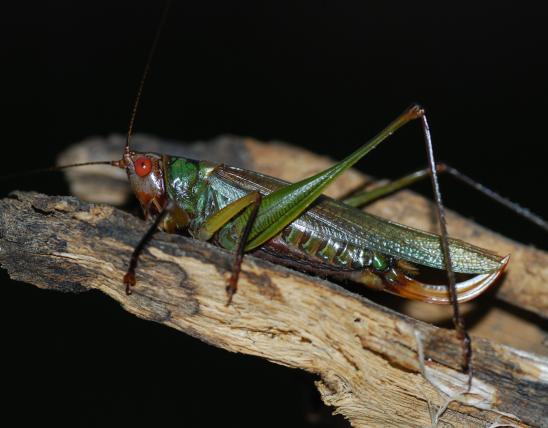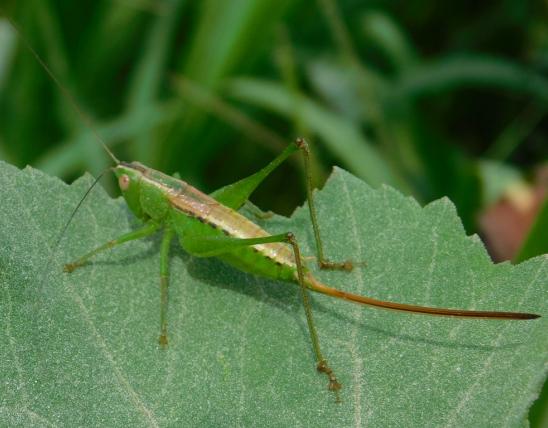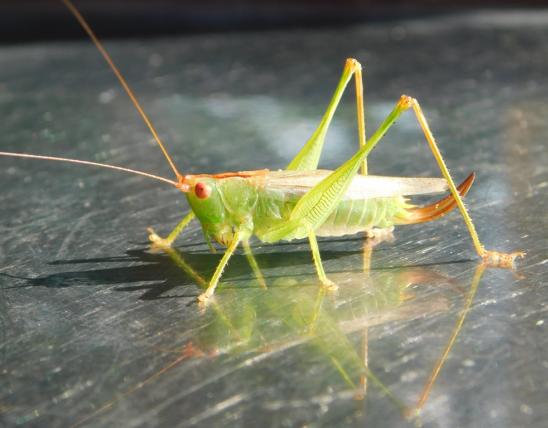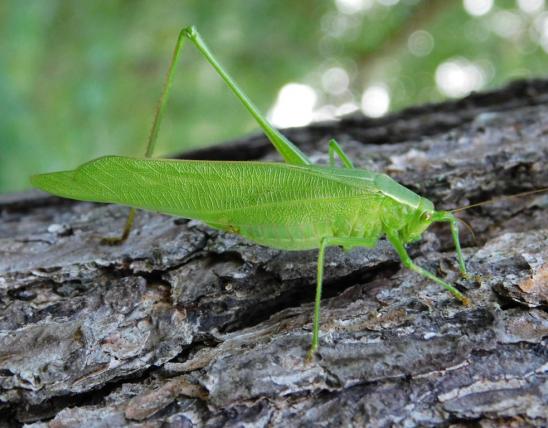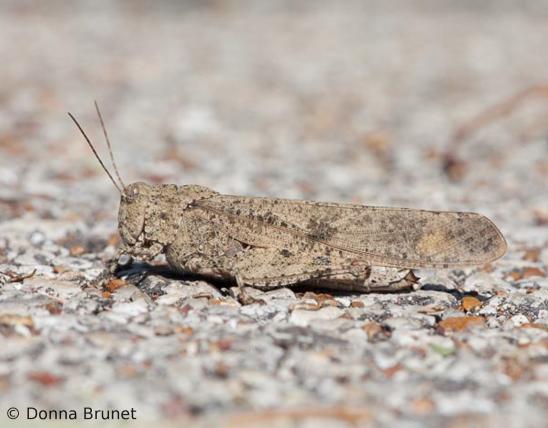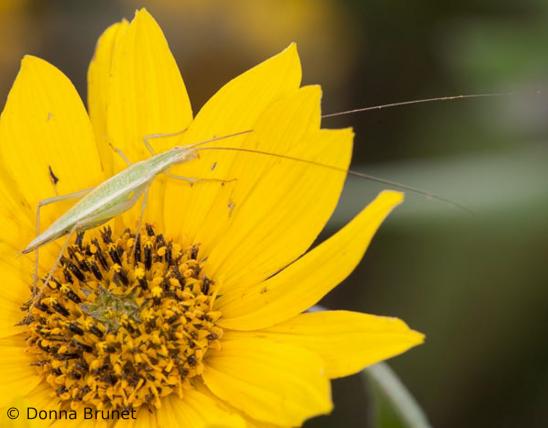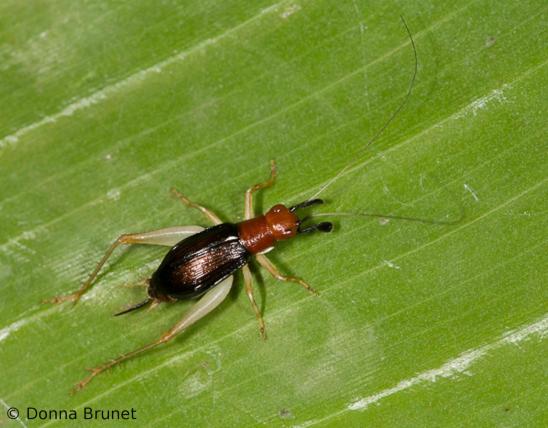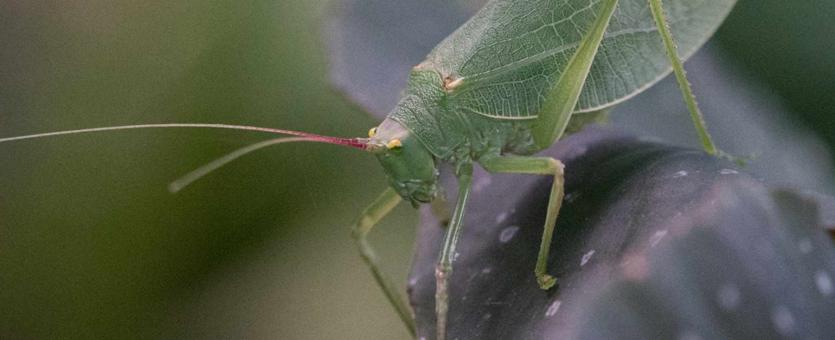
Katydids are a family of insects that may also be called longhorned grasshoppers, because of their super-long antennae. Many resemble green leaves, an effect accentuated by prominent veins on the outer wings. Others are brown. Populations of some species may include individuals that are bright pink or yellow.
Other key identifiers for this family are:
- The ovipositor of females (used for depositing eggs) is usually flattened and swordlike.
- The wings are positioned over the body in a rooflike shape.
- The antennae are usually so long they extend beyond the tip of the abdomen.
- Each foot (tarsus) has four segments.
- The shinlike segments (tibias) of the two forelegs have the hearing organs (these look like little oval holes in the leg).
There are 6 subfamilies of katydids in North America north of Mexico.
Katydids, like their relatives the crickets, are famous insect singers. The sound is produced as they rasp their wings together. The wings are often positioned to amplify the sound. The males sing to attract females and claim territory against other males. In some species, the females may call, too. The calls are unique to each species and can be used to tell species apart. Scientists use sonograms (graphic representations of the sounds, showing pitch and time) to describe and study the songs.
Some common Missouri species include:
- Common true katydid (Pterophylla camellifolia), the species that sings the famous raspy, staccato "katy-did, katy-didn't" call from high in trees in late summer evenings. The legs are relatively short for its large size (body length to 2 inches long). The oval wing covers, which look like green leaves, bulge outward.
- Lesser angle-winged katydid (Microcentrum retinerve) belongs to a subfamily called false katydids, or Phaneropterine katydids. It doesn't sing "katy did, katy didn't." Instead, it stridulates a quick, 3–5-pulsed rattle, with a second or two of silence between rattles: "Tttt! . . . Ttttt! . . . Ttt!" On its back, behind the pronotum (shoulder-like plate), and in front of the ridge used for song-rasping, there's a distinctive brown patch. Behind the head, there is no tooth along the front edge of the pronotum. Length to just over 2 inches. This species occurs through the southeastern United States.
- Greater angle-winged katydid (Microcentrum rhombifolium) is another member of the false katydid subfamily. It is similar to the lesser angle-winged katydid, but it is larger, lacks the brown spot, and has a small tooth on the front edge of the pronotum. Length to about 2½ inches. Its song is a sharp Dzt! given once every few seconds, plus a fairly even, rapid series of 10–20 tics. It has a broad range, across the eastern and southwestern parts of the United States.
- Oblong-winged katydid (Amblycorypha oblongifolia), another so-called false katydid, is a member of the genus called round-headed katydids, named because the top of the head is rounded. The hind legs in this genus are very long. The oblong-winged katydid is one of the species that can be pink, yellow, orange, or tan instead of green. The rasping organs, in a flattened, elongated triangle behind the pronotum, are dark or blackish. The distinctive call is a single, rapid "tzeety-tik!" with several seconds in between calls.
- Fork-tailed bush katydid (Scudderia furcata) ranges throughout the Lower 48. Its call is a simple "tsip!" given every few seconds. It and others in genus Scudderia are called bush katydids because they are most common in bushes, thickets, and other shrubby areas. Males in this genus are identified by distinctively shaped plates in their tail areas.
- Robust conehead katydid (Neoconocephalus robustus) is a large katydid with a green, cone-shaped head with white sides along the cone. It may be green or occasionally brown. Males sing with their head facing the ground. May reach about 3 inches long. Usually found in grasslands amid tall, coarse grasses, and in croplands with members of the grass family (such as corn and sorghum). The song, a continuous, sustained, sizzling buzz, is extremely loud.
- Sword-bearing conehead (Neoconocephalus ensiger) has a narrow, cone-shaped head that comes to a point. The tip of the cone is marked with black: the black extends down farther on the sides than it does on the underside (in the front); no black is visible from above. Overall color is usually green but may be tan. Females can reach about 2½ inches long. The song is a continuing series of rasps that has been likened to the chugga-chugga sound of an old-fashioned steam locomotive.
- Nebraska conehead (Neoconocephalus nebrascensis) is larger than the sword-bearing conehead but has proportionately shorter wings. It has a long, cone-shaped head; the cone is black underneath (on the front side of the cone). The song is a buzz that lasts for a little over a second, with about a second of space between.
- Common meadow katydid (Orchelimum vulgare) has reddish or orange eyes, an unmottled green face, and a relatively large head. It looks bulky and reaches about 1 inch long. Song is a long, rapid series of skipping tics followed by a dry buzz. The sound, made day and night, has been likened to the sound of a pulsating circular lawn sprinkler as it ratchets around.
- Black-legged meadow katydid (Orchelimum nigripes) is a colorful species with distinctive black and yellow legs and reaches about ¾ inch long. The face is mottled white. The body is a bluer green than is typical for katydids. The cerci (pair of pointy structures at the abdomen tip) are bright yellow. It lives near water in tall shrubs, cattails, and reeds, and is common in shrubby swamps. Song, made day and night, is about 5 skipping tics followed by a long buzz a few seconds long.
- Short-winged meadow katydid (Conocephalus brevipennis) is small, only about ½ inch long. The body is stout, brownish green, with wings shorter than the abdomen. It lives in low vegetation in lush, moist, open fields. Sings day and night. Song is a few tic-tics followed by a relatively faint, high-pitched buzz.
- Straight-lanced meadow katydid (Conocephalus strictus) is common in pastures, old fields, roadsides, and agricultural lands. The ovipositor of the female is remarkably long, a swordlike structure that is longer than the rest of the body. The forewings are very short. The song has been likened to a purr: a droning, relatively soft buzz that sometimes breaks into a series of rapid, skipping tics. A chorus is impressive, but a single individual may escape notice.
Similar species: Other members of order Orthoptera include several families of grasshoppers, including the many types of short-horned grasshoppers, plus grouse locusts, crickets, hump-backed grigs, camel crickets, and mole crickets. None are likely to be confused with katydids.
Statewide. Different species have different distribution patterns.
Habitat and Conservation
Many species, particularly conehead and meadow katydids, are most common in weedy areas, fields, high grasses, fence rows, woodland borders.
The common true katydid is famous for singing from treetops at night. It almost always walks and rarely flies; gliding is more of its thing. Because it rarely leaves the canopy of trees, people usually never see it, although we hear it rasping loudly on late summer nights. In autumn, as the weather grows chilly, these insects become clumsy and may fall to earth. If you see a big green katydid when you're raking leaves in fall, it's probably this species.
To see Missouri's nifty-looking pink katydids, visit a native tallgrass prairie in summer. These pink populations are a form or race of the oblong-winged katydid (Amblycorypha oblongifolia), which is usually leaf-green. The color is caused by genetics, and populations with unusual colors are typically geographically isolated from others of their species. Recently, researchers discovered that pink is actually caused by a dominant gene, and green is a recessive trait: when pink and green individuals interbreed, at least 50 percent of their offspring are pink. Yet the majority of individuals in this species are expressing the recessive, green trait. Apparently, the green individuals predominate in most places because their camouflage works much better, and there are no pink individuals nearby with which to breed.
Food
Most katydids eat plant material, especially leaves. A few species prey on insects or scavenge from a variety of materials.
Status
Some katydids are Missouri species of conservation concern. These include:
- Prairie meadow katydid (Conocephalus saltans)
- Bald cypress katydid (or western cypress katydid) (Inscudderia taxodii)
- Slightly musical conehead (Neoconocephalus exiliscanorus)
- Bog conehead (or slender conehead) (Neoconocephalus lyristes)
Life Cycle
Like other members of order Orthoptera (including the crickets and grasshoppers), katydids have simple development, with no great difference between juvenile and adult forms. Immature individuals are smaller and lack wings.
In several species, female katydids have remarkably long ovipositors (egg-laying appendages), which may look like curved knives or swords. These are not harmful to humans. They are used to deposit eggs.
Human Connections
Katydids may inflict some damage to crops, but generally their populations are low enough not to cause serious problems.
Some large species of katydids, including coneheads and meadow katydids, have strong jaws for cracking open seeds and can give you a hearty nip. Handle with care.
Few people are aware of the diversity of insect singers that fill our summer and fall days and nights with distinct, unique songs, as identifiable as the various bird songs.
Ecosystem Connections
This is what bird food looks like. Katydids are an important link in the food chain between plants and animals such as birds, reptiles, and many mammals, that hunt protein-rich, nutritious insects for a living.
Katydids are important food for great golden digger wasps. The mother wasps capture and paralyze katydids and crickets, fly or haul them to their burrows, then place them in the nest cells as food for their young.
